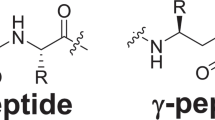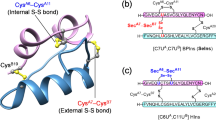Abstract
Insulin-degrading enzyme (IDE), a Zn2+-metalloprotease, is involved in the clearance of insulin and amyloid-β (refs 1–3). Loss-of-function mutations of IDE in rodents cause glucose intolerance and cerebral accumulation of amyloid-β, whereas enhanced IDE activity effectively reduces brain amyloid-β (refs 4–7). Here we report structures of human IDE in complex with four substrates (insulin B chain, amyloid-β peptide (1–40), amylin and glucagon). The amino- and carboxy-terminal domains of IDE (IDE-N and IDE-C, respectively) form an enclosed cage just large enough to encapsulate insulin. Extensive contacts between IDE-N and IDE-C keep the degradation chamber of IDE inaccessible to substrates. Repositioning of the IDE domains enables substrate access to the catalytic cavity. IDE uses size and charge distribution of the substrate-binding cavity selectively to entrap structurally diverse polypeptides. The enclosed substrate undergoes conformational changes to form β-sheets with two discrete regions of IDE for its degradation. Consistent with this model, mutations disrupting the contacts between IDE-N and IDE-C increase IDE catalytic activity 40-fold. The molecular basis for substrate recognition and allosteric regulation of IDE could aid in designing IDE-based therapies to control cerebral amyloid-β and blood sugar concentrations1,8,9.
This is a preview of subscription content, access via your institution
Access options
Subscribe to this journal
Receive 51 print issues and online access
$199.00 per year
only $3.90 per issue
Buy this article
- Purchase on Springer Link
- Instant access to full article PDF
Prices may be subject to local taxes which are calculated during checkout




Similar content being viewed by others
References
Duckworth, W. C., Bennett, R. G. & Hamel, F. G. Insulin degradation: progress and potential. Endocr. Rev. 19, 608–624 (1998)
Kurochkin, I. V. Insulin-degrading enzyme: embarking on amyloid destruction. Trends Biochem. Sci. 26, 421–425 (2001)
Bennett, R. G., Duckworth, W. C. & Hamel, F. G. Degradation of amylin by insulin-degrading enzyme. J. Biol. Chem. 275, 36621–36625 (2000)
Farris, W. et al. Insulin-degrading enzyme regulates the levels of insulin, amyloid β-protein, and the β-amyloid precursor protein intracellular domain in vivo.. Proc. Natl Acad. Sci. USA 100, 4162–4167 (2003)
Farris, W. et al. Partial loss-of-function mutations in insulin-degrading enzyme that induce diabetes also impair degradation of amyloid β-protein. Am. J. Pathol. 164, 1425–1434 (2004)
Leissring, M. A. et al. Enhanced proteolysis of β-amyloid in APP transgenic mice prevents plaque formation, secondary pathology, and premature death. Neuron 40, 1087–1093 (2003)
Miller, B. C. et al. Amyloid-β peptide levels in brain are inversely correlated with insulin activity levels in vivo.. Proc. Natl Acad. Sci. USA 100, 6221–6226 (2003)
Selkoe, D. J. Clearing the brain’s amyloid cobwebs. Neuron 32, 177–180 (2001)
Tanzi, R. E. & Bertram, L. Twenty years of the Alzheimer’s disease amyloid hypothesis: a genetic perspective. Cell 120, 545–555 (2005)
Mirsky, I. A. & Broth-Kahn, R. H. The inactivation of insulin by tissue extracts. I. The distribution and properties of insulin inactivating extracts (insulinase). Arch. Biochem. 20, 1–9 (1949)
Adames, N., Blundell, K., Ashby, M. N. & Boone, C. Role of yeast insulin-degrading enzyme homologs in propheromone processing and bud site selection. Science 270, 464–467 (1995)
Fujita, A. et al. A yeast gene necessary for bud-site selection encodes a protein similar to insulin-degrading enzymes. Nature 372, 567–570 (1994)
Perlman, R. K. & Rosner, M. R. Identification of zinc ligands of the insulin-degrading enzyme. J. Biol. Chem. 269, 33140–33145 (1994)
Li, P., Kuo, W-L., Yousef, M., Rosner, M. R. & Tang, W-J. The C-terminal domain of human insulin degrading enzyme is required for the dimerization and substrate recognition. Biochem. Biophys. Res. Commun. 343, 1032–1037 (2006)
Becker, A. B. & Roth, R. A. An unusual active site identified in a family of zinc metalloendopeptidases. Proc. Natl Acad. Sci. USA 89, 3835–3839 (1992)
Maskos, K. in Handbook of Metalloproteins (eds Messerschmidt, A., Dode, W. & Cygler, M.) 190–198 (John Wiley & Sons, 2004)
Lawrence, M. C. & Colman, P. M. Shape complementarity at protein/protein interfaces. J. Mol. Biol. 234, 946–950 (1993)
Dombkowski, A. A. Disulfide by Design: a computational method for the rational design of disulfide bonds in proteins. Bioinformatics 19, 1852–1853 (2003)
Song, E. S., Juliano, M. A., Juliano, L. & Hersh, L. B. Substrate activation of insulin-degrading enzyme (insulysin). A potential target for drug development. J. Biol. Chem. 278, 49789–49794 (2003)
Chothia, C., Lesk, A. M., Dodson, G. G. & Hodgkin, D. C. Transmission of conformational change in insulin. Nature 302, 500–505 (1983)
Sasaki, K., Dockerill, S., Adamiak, D. A., Tickle, I. J. & Blundell, T. X-ray analysis of glucagon and its relationship to receptor binding. Nature 257, 751–757 (1975)
Braun, W., Wider, G., Lee, K. H. & Wuthrich, K. Conformation of glucagon in a lipid–water interphase by 1H nuclear magnetic resonance. J. Mol. Biol. 169, 921–948 (1983)
Coles, M., Bicknell, W., Watson, A. A., Fairlie, D. P. & Craik, D. J. Solution structure of amyloid β-peptide(1–40) in a water–micelle environment. Is the membrane-spanning domain where we think it is?. Biochemistry 37, 11064–11077 (1998)
Mascioni, A., Porcelli, F., Ilangovan, U., Ramamoorthy, A. & Veglia, G. Conformational preferences of the amylin nucleation site in SDS micelles: an NMR study. Biopolymers 69, 29–41 (2003)
Sticht, H. et al. Structure of amyloid A4-(1–40)-peptide of Alzheimer’s disease. Eur. J. Biochem. 233, 293–298 (1995)
Leissring, M. A. et al. Kinetics of amyloid β-protein degradation determined by novel fluorescence- and fluorescence polarization-based assays. J. Biol. Chem. 278, 37314–37320 (2003)
Taylor, A. B. et al. Crystal structures of mitochondrial processing peptidase reveal the mode for specific cleavage of import signal sequences. Structure 9, 615–625 (2001)
Luciano, P. & Geli, V. The mitochondrial processing peptidase: function and specificity. Experientia 52, 1077–1082 (1996)
La Fortelle, E. & Bricogne, G. Maximum-likelihood heavy-atom parameter refinement in the MIR and MAD methods. Methods Enzymol. 276, 472–494 (1997)
Emsley, P. & Cowtan, K. Coot: model-building tools for molecular graphics. Acta Crystallogr. D 60, 2126–2132 (2004)
Acknowledgements
We thank the staff of APS SBC 19-ID and Biocars 14-BM-C, P. Li and Q. Guo for help with data collection; M. Manolopoulou for help with protein purification; H. Im for help with IDE enzymatic assays; D. Wolfgeher for help with mass spectrometry; E. Johnson for providing the synthetic Aβ(1–42) peptide; and R. Bourdeau for critically reading the manuscript. This research was supported by NIH and The University of Chicago Diabetes Center grants to W.T. Author Contributions W.T. designed the experiments and Y.S. conducted all experiments. W.T. and Y.S. analysed the results and co-wrote the paper. All authors discussed the results and commented on the manuscript.
Author information
Authors and Affiliations
Corresponding author
Ethics declarations
Competing interests
Coordinates of the X-ray structures of the substrate-bound IDE have been deposited in the RCSB Protein Data Bank under accession code 2G54 (Zn2+-IDE–insulin-B-chain), 2G56 (Zn2+-free IDE–insulin-B-chain), 2G47 (IDE–Aβ(1–40)), 2G48 (IDE–amylin) and 2G49 (IDE–glucagon). Reprints and permissions information is available at npg.nature.com/reprintsandpermissions. The authors declare no competing financial interests.
Supplementary information
Supplementary Notes
Supplementary Figures 1–16 and Supplementary Tables 1–2. (PDF 2833 kb)
Rights and permissions
About this article
Cite this article
Shen, Y., Joachimiak, A., Rich Rosner, M. et al. Structures of human insulin-degrading enzyme reveal a new substrate recognition mechanism. Nature 443, 870–874 (2006). https://doi.org/10.1038/nature05143
Received:
Accepted:
Published:
Issue Date:
DOI: https://doi.org/10.1038/nature05143
This article is cited by
-
Diselenide-bond replacement of the external disulfide bond of insulin increases its oligomerization leading to sustained activity
Communications Chemistry (2023)
-
Presence of immunogenic alternatively spliced insulin gene product in human pancreatic delta cells
Diabetologia (2023)
-
Dynamical analysis of a glucose-insulin regulatory system with insulin-degrading enzyme and multiple delays
Journal of Mathematical Biology (2023)
-
Inhibition of Insulin Degrading Enzyme to Control Diabetes Mellitus and its Applications on some Other Chronic Disease: a Critical Review
Pharmaceutical Research (2022)
-
Substrate-selective inhibitors that reprogram the activity of insulin-degrading enzyme
Nature Chemical Biology (2019)
Comments
By submitting a comment you agree to abide by our Terms and Community Guidelines. If you find something abusive or that does not comply with our terms or guidelines please flag it as inappropriate.



